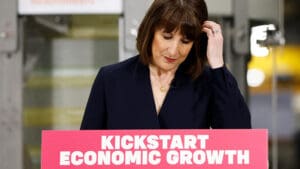The UK economy unexpectedly contracted for a second consecutive month in October, underlining the fragility of growth as households and businesses reined in activity ahead of the Chancellor’s Autumn Budget.
Gross domestic product fell by 0.1 per cent in October, matching the decline seen in September, according to figures published by the Office for National Statistics. Economists had expected the economy to return to modest growth, forecasting an expansion of 0.1 per cent at the start of the fourth quarter.
The data showed that momentum failed to recover after disruption in September caused by a cyberattack that halted production at Jaguar Land Rover for much of the month. On a rolling three-month basis, output also fell by 0.1 per cent, pointing to a broader loss of economic traction.
Construction was the weakest-performing sector, with activity down 0.6 per cent in October, while the dominant services sector contracted by 0.3 per cent, marking its worst performance in three months. Production output rose by 1.1 per cent as car manufacturing rebounded following the end of the JLR shutdown, with vehicle output jumping 9.5 per cent.
Economists said the renewed slowdown reflected growing caution across the economy in the run-up to the Budget, alongside a cooling labour market and persistently high inflation. Callum McLaren-Stewart, an economist at Citi, said uncertainty over potential tax rises had likely discouraged consumer spending, while businesses delayed investment decisions amid a lack of clarity over which sectors would be affected.
The ONS said companies across a wide range of industries reported holding back activity while awaiting the outcome of the Budget, including manufacturers, construction firms, wholesalers, technology businesses, real estate companies and employment agencies.
The weak figures prompted some forecasters to downgrade their outlook for the final quarter of the year. Analysts at Deutsche Bank cut their fourth-quarter growth forecast to 0.1 per cent, citing lingering Budget-related uncertainty and subdued business investment.
Business groups including the CBI and the British Chambers of Commerce have warned that the Budget is unlikely to deliver a sustained uplift in growth over the next two years, despite the government’s plans to increase spending in the near term, funded by tax rises later in the parliament.
The Treasury said the government remained determined to boost growth, create jobs and invest in public services. Schools minister Georgia Gould said there were “green shoots” following the resumption of car production, though economists cautioned that underlying conditions remain weak.
The figures come ahead of the Bank of England’s final interest rate decision of the year next week. With GDP contracting and signs of labour market softening, investors are increasingly expecting the Monetary Policy Committee to consider a rate cut from the current 4 per cent.
Read more:
UK economy unexpectedly contracts again as growth stalls ahead of Budget










